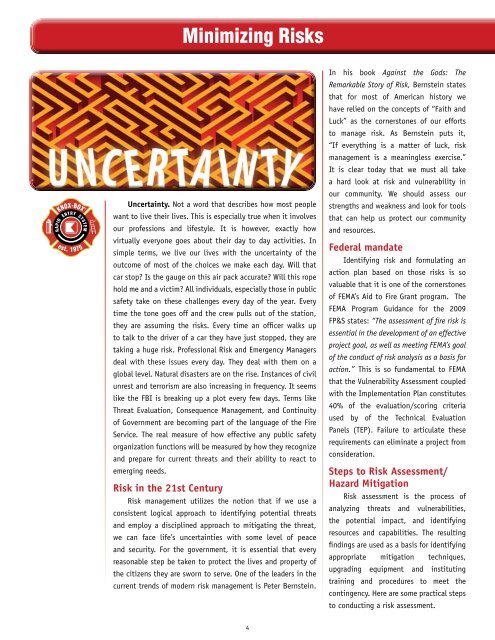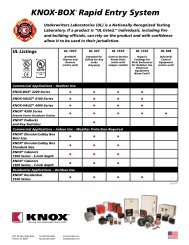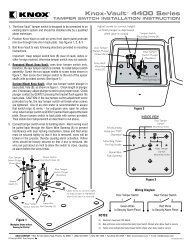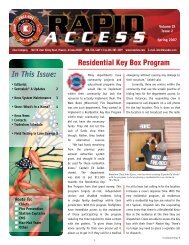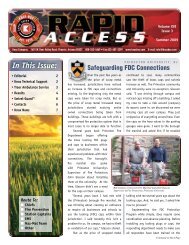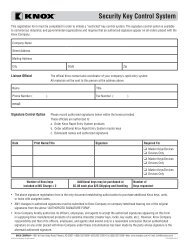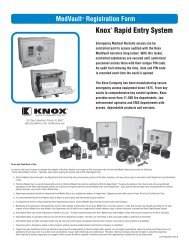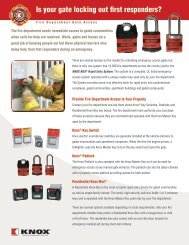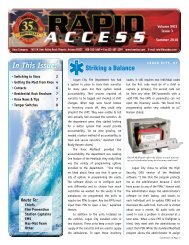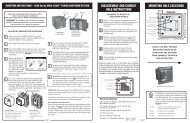In This Issue: - Knox Box
In This Issue: - Knox Box
In This Issue: - Knox Box
Create successful ePaper yourself
Turn your PDF publications into a flip-book with our unique Google optimized e-Paper software.
Minimizing Risks<br />
Uncertainty. Not a word that describes how most people<br />
want to live their lives. <strong>This</strong> is especially true when it involves<br />
our professions and lifestyle. It is however, exactly how<br />
virtually everyone goes about their day to day activities. <strong>In</strong><br />
simple terms, we live our lives with the uncertainty of the<br />
outcome of most of the choices we make each day. Will that<br />
car stop Is the gauge on this air pack accurate Will this rope<br />
hold me and a victim All individuals, especially those in public<br />
safety take on these challenges every day of the year. Every<br />
time the tone goes off and the crew pulls out of the station,<br />
they are assuming the risks. Every time an officer walks up<br />
to talk to the driver of a car they have just stopped, they are<br />
taking a huge risk. Professional Risk and Emergency Managers<br />
deal with these issues every day. They deal with them on a<br />
global level. Natural disasters are on the rise. <strong>In</strong>stances of civil<br />
unrest and terrorism are also increasing in frequency. It seems<br />
like the FBI is breaking up a plot every few days. Terms like<br />
Threat Evaluation, Consequence Management, and Continuity<br />
of Government are becoming part of the language of the Fire<br />
Service. The real measure of how effective any public safety<br />
organization functions will be measured by how they recognize<br />
and prepare for current threats and their ability to react to<br />
emerging needs.<br />
Risk in the 21st Century<br />
Risk management utilizes the notion that if we use a<br />
consistent logical approach to identifying potential threats<br />
and employ a disciplined approach to mitigating the threat,<br />
we can face life’s uncertainties with some level of peace<br />
and security. For the government, it is essential that every<br />
reasonable step be taken to protect the lives and property of<br />
the citizens they are sworn to serve. One of the leaders in the<br />
current trends of modern risk management is Peter Bernstein.<br />
<strong>In</strong> his book Against the Gods: The<br />
Remarkable Story of Risk, Bernstein states<br />
that for most of American history we<br />
have relied on the concepts of “Faith and<br />
Luck” as the cornerstones of our efforts<br />
to manage risk. As Bernstein puts it,<br />
“If everything is a matter of luck, risk<br />
management is a meaningless exercise.”<br />
It is clear today that we must all take<br />
a hard look at risk and vulnerability in<br />
our community. We should assess our<br />
strengths and weakness and look for tools<br />
that can help us protect our community<br />
and resources.<br />
Federal mandate<br />
Identifying risk and formulating an<br />
action plan based on those risks is so<br />
valuable that it is one of the cornerstones<br />
of FEMA’s Aid to Fire Grant program. The<br />
FEMA Program Guidance for the 2009<br />
FP&S states: “The assessment of fire risk is<br />
essential in the development of an effective<br />
project goal, as well as meeting FEMA’s goal<br />
of the conduct of risk analysis as a basis for<br />
action.” <strong>This</strong> is so fundamental to FEMA<br />
that the Vulnerability Assessment coupled<br />
with the Implementation Plan constitutes<br />
40% of the evaluation/scoring criteria<br />
used by of the Technical Evaluation<br />
Panels (TEP). Failure to articulate these<br />
requirements can eliminate a project from<br />
consideration.<br />
Steps to Risk Assessment/<br />
Hazard Mitigation<br />
Risk assessment is the process of<br />
analyzing threats and vulnerabilities,<br />
the potential impact, and identifying<br />
resources and capabilities. The resulting<br />
findings are used as a basis for identifying<br />
appropriate mitigation techniques,<br />
upgrading equipment and instituting<br />
training and procedures to meet the<br />
contingency. Here are some practical steps<br />
to conducting a risk assessment.<br />
4


